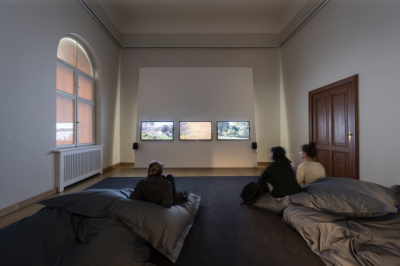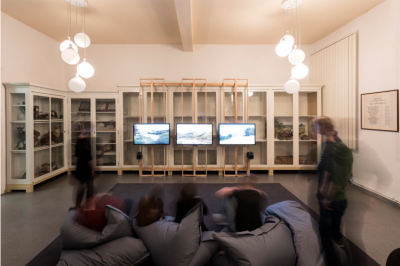
One to One
Verschwindende Vermächtnisse
Die Welt als Wald
Zoological Museum of CeNak, University of Hamburg (2017)
Tieranatomisches Theater (TA T), Humboldt-Universität, Berlin (2018)
Zentralmagazin Naturwissenschaftlicher Sammlungen, Halle (2018)

What is it that we are looking at? What stares back at us?
One to One takes the viewer through two case studies of landscapes where remaking in terms of art is activated against the destruction of that landscape, as 'examples' of colonial observations that usually and almost immediately mandated eradication of that very landscape. Von Humboldt believed that works of art could provide important information and that artists could visualize aspects of the environment and uncover the complexities of the earth, in a way that scientists could not. These case studies speak to that.
In 1855, landowner James Dawson asked painter, botanist and former gold-digger Eugene von Guérard to paint Tower Hill, a volcanic area in Victoria, Australia. In almost photographic detail this painting depicts the vegetation as the Aborigines knew it and just before intensive European settlement caused rapid degradation of the site by the 1860s. By then, the vegetation on the sides of the volcano was cleared or burned to create land for livestock and crops, while most of the trees were taken for fuel or building material. In the 1960s, one century later, Von Guérard's painting was used as a model, map, guide and botanical template, when the land was systematically reclaimed, reforested with native flora, and made into a state park.
About 80 per cent of the re-planting of trees and shrubs was done with the help of hundreds of school children, naturalists and volunteers. Today, Tower Hill resembles the painting of Von Guérard, though the landscape is still far from what it was before its destruction.
“I can make more and better landscapes in this way than by tampering with canvas and paint in the studio”, wrote Frederic Church, the artist who made the famous painting The Heart Of The Andes in 1859, four years after Eugene von Guérard painted Tower Hill. And thus, Church stopped painting and created a one to one, life size landscape of 1 km2 at Olana on the Hudson River, now one of the most important surviving picturesque landscapes in the United States. Remaking the world as an earth sculpture.
Both observational practices are privileging details and a mode of representation, on the page, on the canvas, in the world: this was the point of departure for Church and Von Guerard. The video One to One (duration 17 min., voice actor Tor Jonsson) with a script built on a variety of sources, reflects on what it means to see in detail. One to One was first presented at Verschwindene Vermächtnisse in Hamburg, Berlin, and Halle. Replicating Nature, a fieldtrip in this context, was organised by the artists and curators. See also
 installation shot One to One, 2 channel version
installation shot One to One, 2 channel version
 installation shot One to One, 3 channel version
installation shot One to One, 3 channel version
 installation shot One to One, 3 channel version
installation shot One to One, 3 channel version